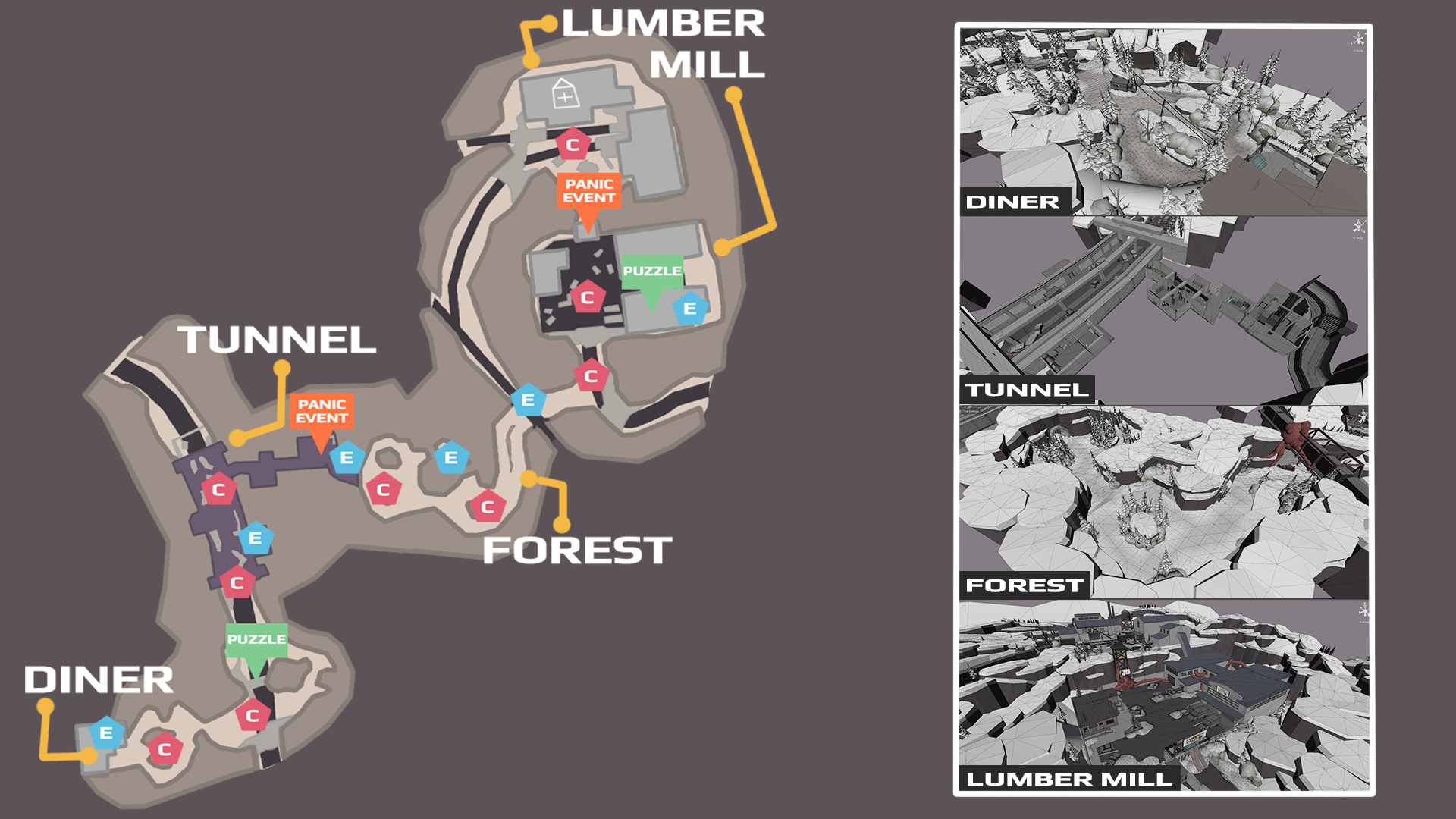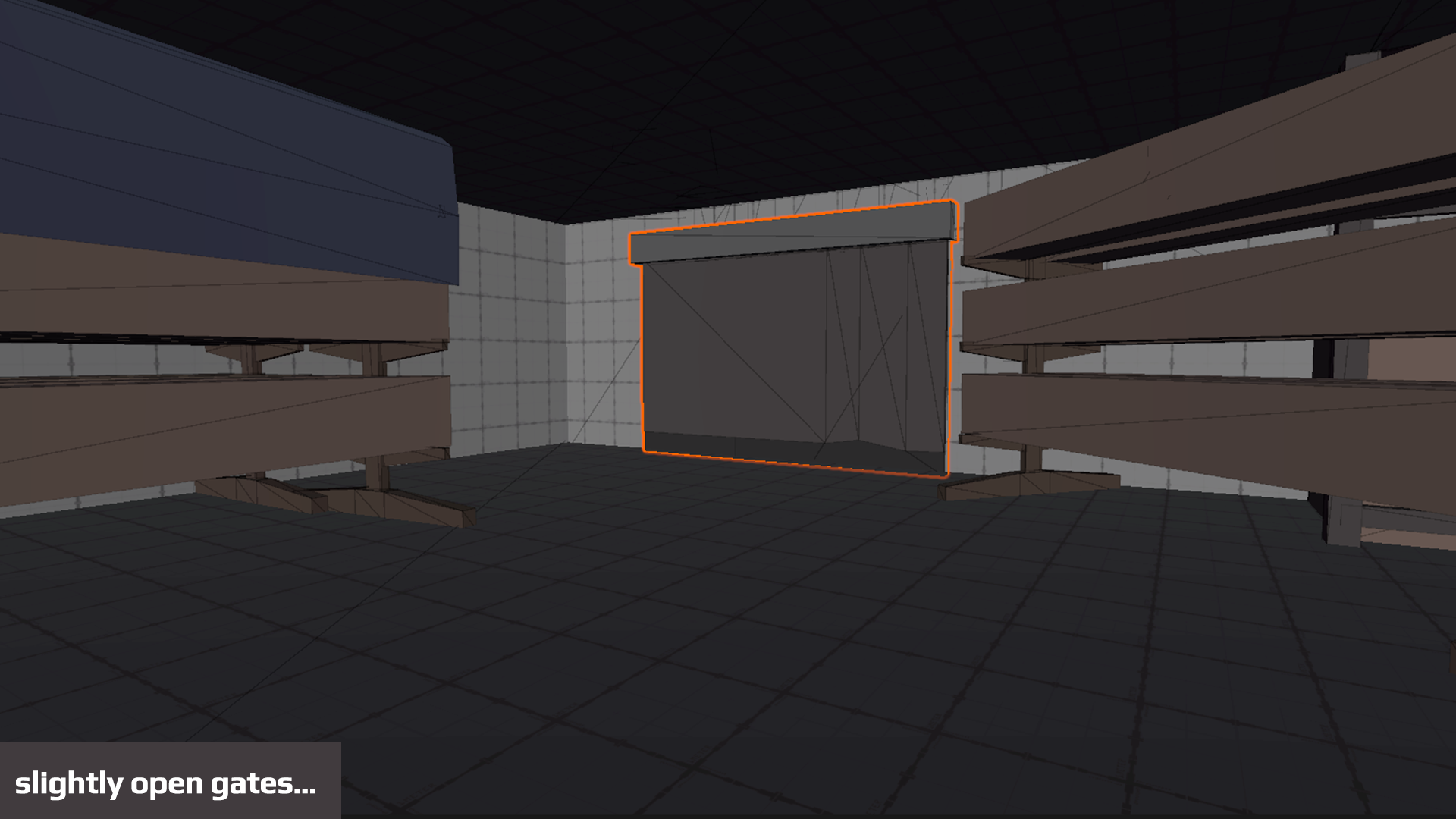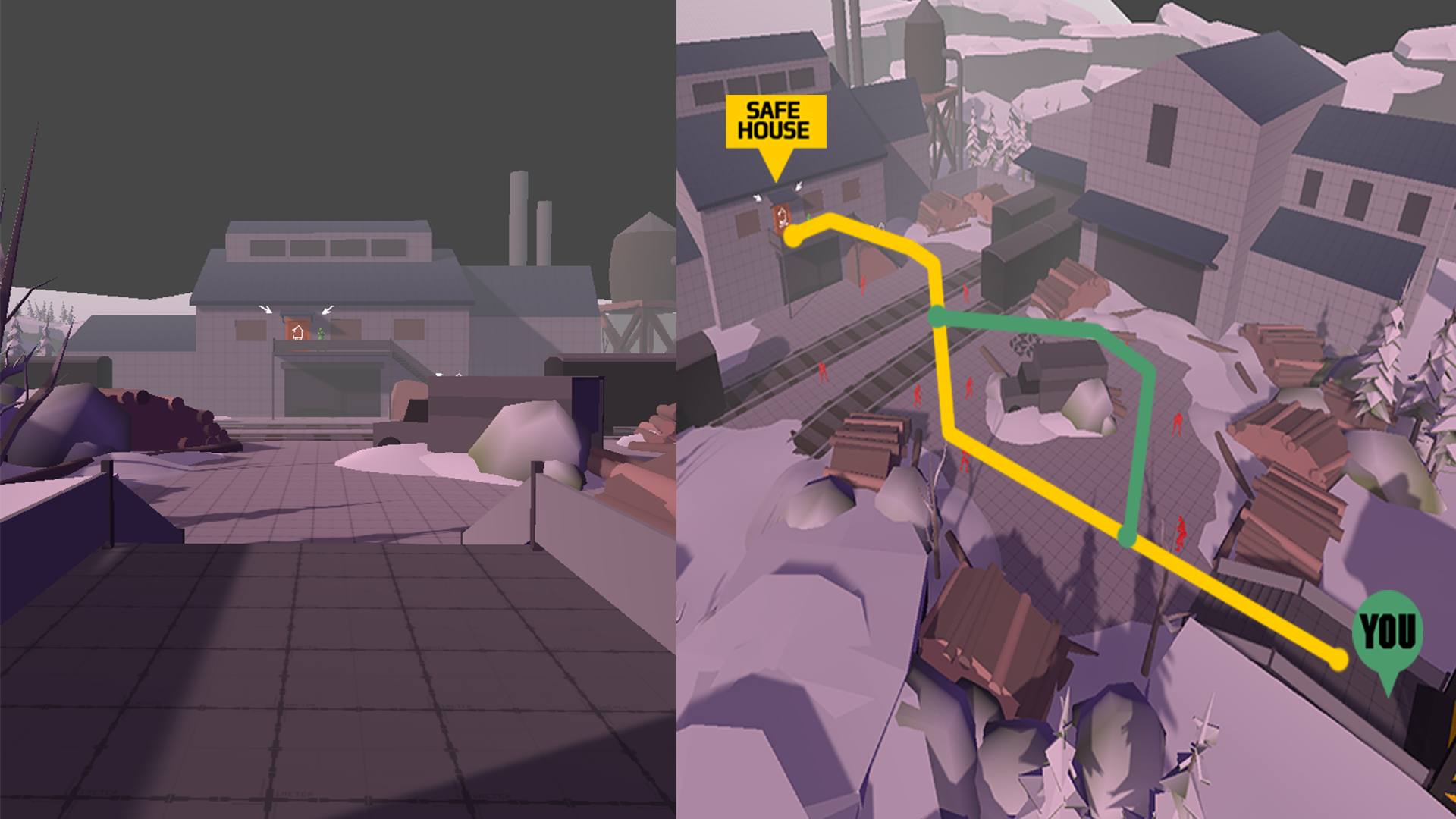Level Design of Co-op FPS for Back4Blood
My goal was to create a co-op first-person shooter level inspired by Back 4 Blood by Turtle Rock Studios. I focused on delivering strong pacing and engaging challenges while building an immersive world that players would want to explore.
To build the level, I used Unity with ProBuilder for the blockout, Playmaker for visual scripting, and the Zombie Shooter Prototype by Meka Games.
You can play the level here, download a PDF breakdown, or watch the gameplay video with commentary on YouTube.
Level Layout
I wanted to convey the feeling of a cold, dangerous winter and build the level around strong visual and spatial contrasts. It was also important to create areas that encourage both exploration and combat, while introducing co-op-focused challenges that require teamwork and coordination. That’s why I divided the level into the following key areas:
- Diner — The level starts in a cozy, welcoming space. Despite the post-apocalyptic setting, I used the diner to create a warm, almost festive mood. It serves as the players’ base on New Year’s Eve.
- Tunnel — A sharp contrast follows. The space narrows, increasing tension and presenting a new kind of challenge in tight, dark corridors.
- Forest — After the confined tunnel, players enter a wide-open snowy landscape. The forest restores a sense of freedom but introduces fresh threats and combat scenarios.
- Lumber Mill — The final area combines all elements: a large-scale battle with hordes of zombies, a spatial puzzle, and a tense push toward the Safe House.

Exploration
At the start of the level, I wanted to show that exploration is rewarded. While searching the shelter, players can find useful items that will help them later. These items are placed in logical, believable spots — like a Molotov near the bar, coins by the jukebox, and supplies in the kitchen — to make the world feel grounded and alive.
To ensure players are prepared, the vendor and weapons are placed right at the exit, so they can gear up before entering the dangerous zone.
Throughout the level, hidden supply stashes marked with graffiti encourage further exploration. Access often comes with risk — such as alarmed doors. Players can peek inside through a hole in the wall and decide whether the reward is worth the danger.
Navigation
To help players navigate and guide them naturally, I used local landmarks designed with strong composition to support immersion and environmental storytelling. For example, a van crashed into a pole — it not only helps players stay oriented but also sparks curiosity: “What the heck happened here?” Details like this make the world feel alive and memorable.
Even though the level follows a linear structure, I introduced path variations to create a sense of choice and make the level feel larger than it is.
At the tunnel exit, players find their path blocked by barricades. It may seem like a dead end, but turning around reveals car headlights pointing toward the correct door. To make the direction even clearer, I added a yellow hose leading to the same spot — a simple but effective visual cue.
Combat
I tried to ease players into combat gradually. Near the exit from the shelter, I placed a stationary enemy with a small detection radius. It doesn’t react immediately, giving players a safe opportunity to use their weapon for the first time without pressure.
As the level progresses, I introduce new threats to keep the gameplay dynamic. At the tunnel entrance, I placed a trap: players might notice a room with supplies, but nearby is a van hiding a Sleeper — a wall-mounted zombie that ambushes anyone who gets too close. More observant players can hear it snoring and choose to avoid the danger.
I also planned to introduce a new enemy type — zombies that burst out from under the snow, adding surprise and intensity. While this mechanic wasn’t fully implemented, it was designed to shift the pace and keep players alert.
Throughout the level, I aimed to create variety in enemy types and situations to maintain tension and keep the co-op experience fresh and engaging.
Enemy Spawn Points
It’s important to keep enemy spawn points hidden from the player’s view. I placed them behind slightly open gates, inside small side rooms, or around corners to make enemy appearances feel natural and immersive. This helps maintain tension without breaking the illusion of a living, reactive world.

Panic Events
Panic events are scripted moments designed to trigger waves of enemies and create intense, chaotic gameplay. They break the usual rhythm and force players to adapt quickly, often under pressure and with limited resources.
I placed these events in the middle and toward the end of the level to increase tension at key moments. One starts with an alarmed door that triggers endless enemy spawn. Behind the door, a tall ladder forces players to climb one by one. As the group splits — some climbing, others hold off the horde — under constant pressure and low on ammo.
Another is triggered by activating a loud, rusty elevator. Players are trapped in the arena and must defend themselves while the elevator slowly comes down.
With nowhere to run, the team must hold their ground under growing pressure.
Rest Areas
After each Panic Event, players enter rest areas that provide contrast and help balance the pacing. These moments give players a chance to recover, explore, and prepare for upcoming challenges.
One rest area is a small supply room where players can heal and resupply. Another is the elevator ride itself — a quiet moment with no enemies, where players can look back at the path they’ve taken. These calmer sections create emotional contrast and keep the overall experience from feeling overwhelming.
Main Puzzle
In the final arena, players encounter a massive Plague Heart blocking access to the elevator that leads to the final area. To unlock the elevator, they must first weaken the heart by destroying two connected nodes.
One node is located in an office, the other in a warehouse. Destroying each node triggers a zombie horde, increasing the pressure and requiring strong team coordination.
The second node includes a small spatial puzzle. While the node is visible on the second floor, the staircase leading to it is broken. Players must explore the warehouse, find a forklift, and use it to create an improvised way up.
Safe House
When players reach the final section, the Safe House is clearly visible in the distance, giving them a strong sense of direction. To make it stand out even more, I placed a survivor at the entrance, fighting off zombies. This moment not only draws attention to the goal but also reinforces the idea that the world is active and alive — things are happening with or without the player.

Conclusion
This project allowed me to explore co-op gameplay, level pacing, and environmental storytelling within a first-person shooter setting. I focused on creating a balanced experience with a mix of combat, exploration, and scripted events. The process helped me strengthen my skills in layout design, player guidance, and gameplay flow.















